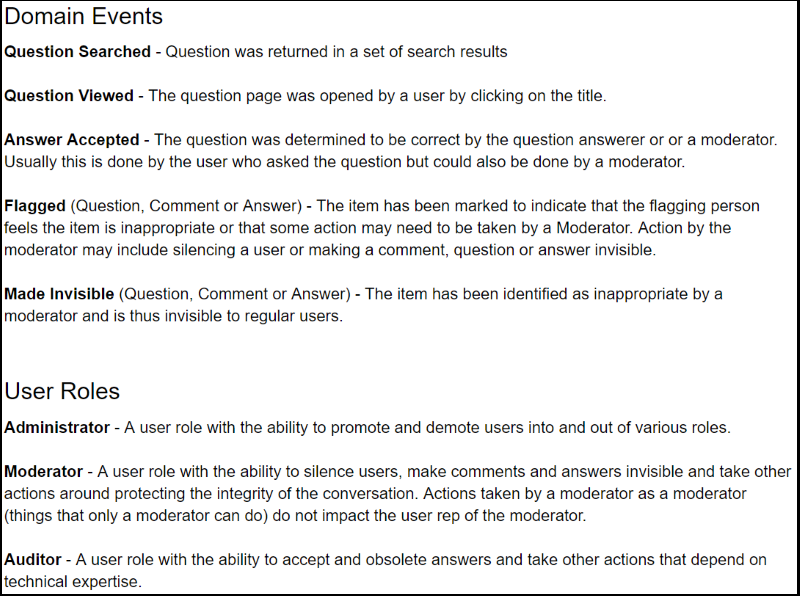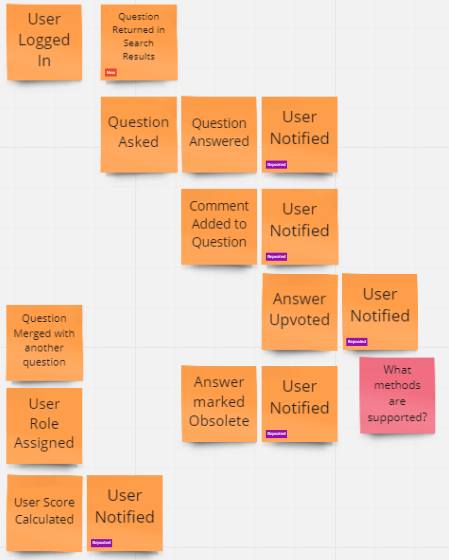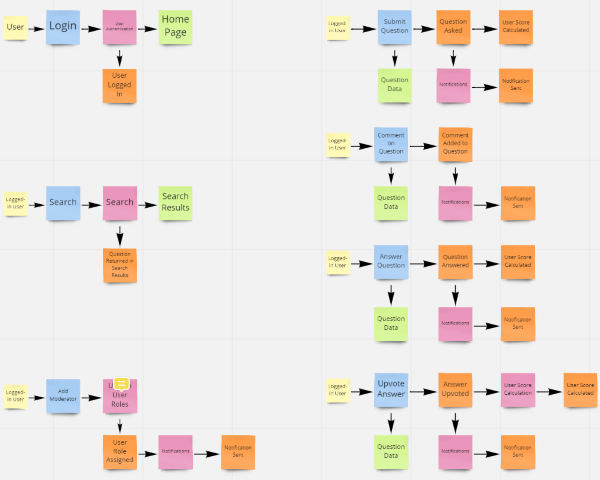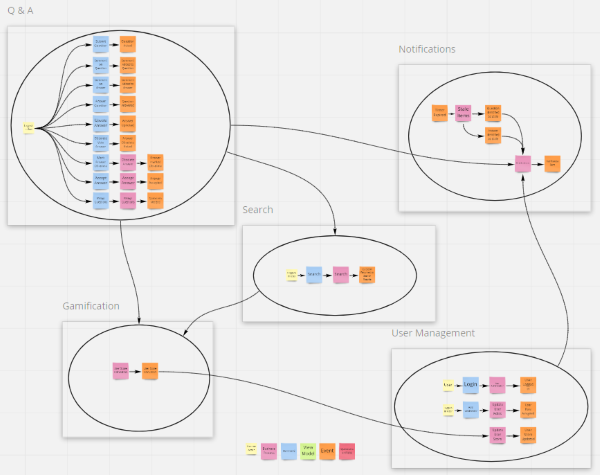Event Storming
Posted by bsstahl on 2021-09-21 and Filed Under: development
What is Event Storming?
Event storming is a process for building a model of a problem domain by analyzing the domain from a business perspective. The results of an Event Storming session include a logical model of the domain, as seen by the business owners, that is extremely useful to engineers in defining software systems for that domain. Event Storming follows a four-step process to produce a model of the system that is based on Domain Events, historical facts about the business process that are relevant to the business owners.
The process occurs on a whiteboard surface, ideally in-person but often virtually. Sticky-notes of various colors are used to represent elements of the domain and the model is built-up by everyone on the team, regardless of their role. The exercise starts as a brainstorming session of a sort, then evolves until it results in a model of the business process.
The Goals of Event Storming
Produce a model of the domain that is valuable to both the business owners and the engineers who are building software systems for that domain.
Document a Ubiquitous Language for the domain that represents the shared set of terms used by everyone working in that domain.
Level everyone in the domain on the same understanding of what problems are being solved so that all players have a strong working background.
Important Terminology
Note: The items below represent the different elements of the model we wish to produce. Each type of item is represented by a different color of sticky-note on our design surface. Terms not color-coded exist in the context of Domain Driven Design and may be used during the session, but will not be modeled on the board.
Aggregate
An aggregate is a cluster of domain objects that can be treated as a single unit. An example may be an order and its line-items. These objects will likely be created from distinct classes when built within the context of a software system, but it is useful to treat them as a single aggregate for the purposes of modeling the domain. That is, it is simpler to think about an Order with all of its line-items as a single unit within the model. Additionally, some objects will be able to be viewed from multiple perspectives. If we model a User which contains a collection of Roles, we could also see a Role as having a collection of users. The User and Role objects are each separate aggregates and can be modeled separately depending on the context, even though they represent the same relationship and a collection of one object likely exists on the other. The primary object within each Aggregate is known as the Aggregate Root which is used to describe the aggregate as a whole.
Bounded Context
A Bounded Context is a logical area within a system where business processes are implemented, a ubiquitous language is applied, and certain terms make very clear and specific sense. A term can have exactly one meaning within a bounded context, a meaning which may not be exactly the same as that same term in another bounded context. As an example, let's look at a Customer object. Bounded Contexts that exist in a state after a user has logged-in to the system might have a User object or UserId property associated with it. Meanwhile, this User object or UserId may not exist in a Bounded Context that exists purely pre-login, or where login status has no bearing on the functionality.
Business Process (dark purple stickies)
The business rules and logic required to handle a Command or a Domain Event. A business process may create one or more domain events, or may reject the command outright.
Command (light blue stickies)
An instruction submitted by a user, usually through a view, that typically results in the creation of one or more Domain Events. Commands may be rejected by the Business Processes that handle them, perhaps due to permissions or data validation issues. If a command is rejected, it may or may not result in one or more domain events representing the submission and/or rejection of that command.
Domain Event (orange stickies)
Domain Events are the keys to Event Storming. A Domain Event is something that happened in the domain that is relevant to the business. Events are always written in the past tense since they represent historical facts that cannot change. Examples of domain events include “vehicle locked” and “delivery scheduled.” Though the term event is somewhat overloaded, these Domain Events should not be conflated with the messages that can be used to represent them. While many Domain Events will eventually be represented by event messages of some form, many will not. Event Storming is an implementation agnostic process, thus there is no prescription as to how events are communicated. Domain events, in this context, exist entirely as historical facts and nothing more.
External System (light purple stickies)
A third-party service provider such as a payment gateway or shipping company. These services may utilize View Models within our system and may create Domain Events that trigger Business Processes.
Questions or Risks (pink or red stickies)
We use pink stickies to identify items that are unclear, overly complex or have unanswered questions or risks. Callout concerns with these pink stickies liberally whenever there is something that should be known about an item or area of the model. Sections of the model where there are a lot of pink sticky notes may require additional attention.
Ubiquitous Language
A set of terms describing the domain that are meaningful to the business team. These are the terms that are used by all domain team members to identify and communicate about activities of the system. A sample excerpted from a Ubiquitous Language document is shown below.

User/Actor (yellow stickies)
A person who interacts with the system. These interactions will usually take the form of executing a Command, typically through a view populated by a View Model.
View / Read Model (light green stickies)
A presentation of data that Users, Business Processes, and External Systems interact with to carry out a task in the system. As an example, an external system may call a REST service within the domain that returns data that we represent with a View Model.
The Event Storming Process
Each step builds on the previous steps to result in a cohesive picture of the domain from a business perspective. This view of the system has proven to be extremely useful to engineers in defining software systems for that domain.
1 - Collect Domain Events
The first step in Event Storming is to brainstorm the Domain Events that occur during the course of the business process. These events should be described on orange sticky notes using verbs in the past-tense. Each sticky should represent a single event and should be placed on the modeling surface in roughly chronological order. Since this is brainstorming, we should limit the amount of time we spend discussing and refining each event. There will be more time for that in step 2. However, we do want to have enough discussion to trigger thoughts on additional events which often result from these conversations.
Any events where there are unresolved questions or concerns should be marked with a pink sticky note indicating the question or risk. In this first step we should make liberal use of these stickies.

2 - Refine Domain Events
Once we have thrown all of the events we can think of on the board, we can start to refine those events. In step 1 we were brainstorming so multiple side-conversations may have been occurring at various times. In step 2 we want to bring the entire team together in a single conversation about each event. This is where we drill-in to the details of the events, and modify our model as appropriate.
We begin by walking through the timeline, usually from left to right, but jumping around as needed to best navigate the domain. Each event should be discussed with all participants to be certain that the entire team understands the details of the event. Other things to discuss include whether or not the event is in the proper place on the timeline, if there are any additional events that may be related to the one being discussed, if any duplicate events should be combined, if any of the questions or risks identified in the pink stickies can be resolved, and if there are additional questions or concerns that should be called-out using pink stickies.
Finally, for each event, be certain that any important terms are documented in the Ubiquitous Language document and that we are not using synonyms of the documented terms to describe our events. We always want to use the correct terminology to describe all aspects of our domain.

3 - Track Causes
In step 3, things start to get really interesting. The goal of this step is to determine the causes of each of the Domain Events. There are three causes of domain events: User actions, Business Processes, and External Systems. For each event we need to identify the interactions surrounding it, including what triggers it, and what downstream events it may cause. This step, once completed, results in a model that looks like a series of flows.
User Actions
Users typically trigger events via View Models and Commands. A view model may be displayed to the user from which they issue a command to take an action. This command may directly result in a Domain Event, but is more likely to be consumed by a Business Process which may validate the command before either rejecting it or executing logic that results in a Domain Event.
Business Processes
Business Processes often produce one or more events during the execution of their logic. An example might be that when a question is answered by a user in a StackOverflow type Q & A domain, it results in a “Question Answered” event. This event may be consumed by a business process to notify subscribed users resulting in one or more “User Notified” events. Business Processes often make use of Read Models to provide additional information as to the state of the system.
External Systems
External Systems are business processes that exist outside of the domain, and as such, have a smaller surface with which to interact with our systems. These processes may utilize Read Models from within our domain to gather information and are usually modeled as creating Domain Events to interact with the system. These interactions are typically modeled as Domain Events because most external system events are seen as important historical facts to our business. After all, if they weren’t important to our business domain experts, why would our systems care about them at all? This is not a hard and fast rule however and your domain may differ. It is conceivable that external logic could issue Commands to internal systems, though it seems more reasonable that those would be viewed as Domain Events.

4 - Aggregation (Software Modeling)
The final step is all about grouping our new logic flows around the Aggregates they act upon and describing the communications between these newly identified sub-domains.
As you recall, an Aggregate is an object graph treated as a single object and identified by the Aggregate Root. In this step we identify the aggregates in our system, and then group each of the flows from step 3 by the Aggregate they act upon. At the same time, we can draw lines between the groups to identify the communications across these boundaries. This will result in the final model of this process, a set of flows grouped by their Aggregate into subdomains that can often be viewed as a good proxy for a microservice.

Additional Resources
- Intro to Event Storming - Lightning Talk Video
- Event Storming Presentation - Slide Deck
- Alberto Brandolini - Creator of Event Storming - On Why it Should be Done In-Person
- Adam Dymitruk on Event Modeling - a similar (more expansive) system
Conclusion
The practice of Event Storming offers a dynamic and inclusive approach to understanding and modeling business domains, bridging the gap between technical and non-technical stakeholders. By fostering collaboration, promoting a shared language, and visualizing the flow of Domain Events, teams can unlock a deeper comprehension of the business processes at hand. This method not only streamlines the development process but also ensures that the resulting software systems are precisely aligned with business objectives. As we've seen, Event Storming stands out as an invaluable tool in the arsenal of modern software development practices, embodying principles of agility, domain-driven design, and team cohesion to tackle complex domain problems effectively.